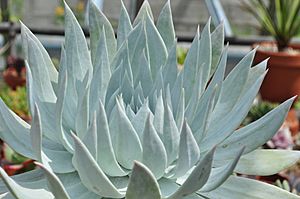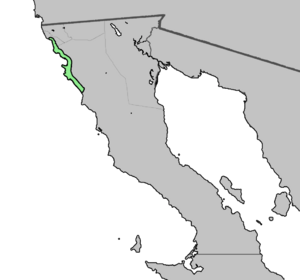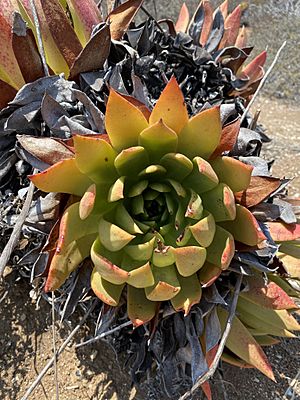Dudleya brittonii facts for kids
Quick facts for kids Britton's Dudleya |
|
|---|---|
 |
|
| Dudleya brittonii at the Wave Hill public garden, Bronx, New York | |
| Scientific classification | |
| Genus: |
Dudleya
|
| Species: |
brittonii
|
 |
|
| Distribution of Dudleya brittonii | |
| Synonyms | |
|
Dudleya candida subsp. brittonii (D.A.Johans.) Moran |
|
Dudleya brittonii, also called Britton's dudleya or giant chalk dudleya, is a type of succulent plant. Succulents are plants that store water in their leaves, like cacti. This plant belongs to the Crassulaceae family. It grows naturally along the coast of northern Baja California, Mexico.
Both types of this plant have yellow leaves that form a round shape called a rosette. These rosettes sit on top of a large reddish-purple stem called a peduncle. One type of the plant is white because it has a chalky, waxy coating. This coating helps it reflect sunlight and react with water. The green type of the plant is more common and grows in more places. Dudleya brittonii is one of the largest plants in the Dudleya group.
Contents
What Does Dudleya brittonii Look Like?
Dudleya brittonii has a short, thick base called a caudex, which is often covered by old, dry leaves. Usually, only one leafy rosette grows from this base. The leaves at the bottom of the plant are many and stand upright. Younger leaves are long and narrow, while older leaves are wider and thicker at their base. These leaves are about 7 to 11 centimeters (about 3 to 4.5 inches) long. Older leaves can be 4.5 to 5.5 centimeters (about 1.8 to 2.2 inches) wide at the bottom. The leaves are flat on top in the middle, but rounded on both sides closer to the base. They often have a reddish tip. As the leaves get older, they can turn a reddish-purple color.
The flowering stem grows up from the bottom leaves. It is thin, stands straight up, and is reddish-purple. Small, leaf-like parts called bracts grow horizontally on the stem. They are very thin, long, and wrap halfway around the stem. These bracts are light green or red and tend to dry up quickly after the plant flowers.

The plant's inflorescence (which is how the flowers are arranged) is shaped like a cyme. It is about 10 centimeters (4 inches) wide but narrow from side to side. It has bright red small branches that hold the upright, slender flower stalks, which are 7 to 9 centimeters (about 3 to 3.5 inches) long.
The flower has a bright green outer layer called a calyx, which is about 5 millimeters (0.2 inches) long. The main part of the flower, called the corolla, stands upright and is about 9 millimeters (0.35 inches) long. It is split almost two-thirds of the way down into long, narrow parts called petals. The petals are very light or pale white, with a yellow line down the middle.
The leaves of the white, chalky type of Dudleya brittonii are covered with a dusty, white, waxy layer. This wax is special because it attracts water and coats water drops on the leaves, which helps prevent the water from evaporating. This wax also reflects more ultraviolet light than any other plant's wax that has been measured!
Dudleya brittonii looks similar to D. pulverulenta, which grows in some of the same areas. It also looks like D. ingens, but that plant only grows further south.
How Dudleya brittonii Was Named
Dudleya brittonii was first found by a person named Mr. Howard E. Gates. He discovered it near a canyon north of the 32nd parallel, somewhere between Descanso and Ensenada in Mexico. Donald A. Johansen officially described and named D. brittonii in 1933. This description was published in the Cactus & Succulent Journal of America.
The plant was named after Nathaniel Lord Britton. He was one of the botanists who first described the entire group of plants known as Dudleya.
The Green Form
Some experts believe that the green type of D. brittonii is actually a separate species. They call it Dudleya viridis.
There are several ways the green form is different from the white, chalky form:
- The green form has leaves that are a distinct apple-green, golden-green, or bright dark green color. The white form has a white color.
- The green form has flower heads that hang downwards, bracts that curve backward, and flowers that are cream yellow, dark yellow, or white. The white form has upright flower heads, horizontal bracts, and pale yellow or white flowers.
- The green form can have many more leaves, from about 40 in young plants to as many as 190 in older plants. This is one of the highest numbers of leaves in the Dudleya group.
- When the green form is resting (dormant), its leaves will curve inward, making it look like a "ball."
Also, the green form flowers much later than the white form, sometimes six weeks or more later, even when they grow in the same place. Researchers who have studied Dudleya brittonii for many years, like Thomas W. Mulroy, agree that both forms should be recognized as distinct types.
Where Dudleya brittonii Grows
Dudleya brittonii grows in the very northwest part of Baja California, Mexico. You can find it from La Misión south to the area around Eréndira, and also on Todos Santos island.
The white, chalky type of the plant grows on cliff faces and steep slopes. The green type grows in rocky areas away from cliffs, and on the flatter slopes of loose rock and soil below cliffs. Unfortunately, new buildings and developments along the Baja California coast are putting this plant species at risk.
Growing Dudleya brittonii
People often grow Dudleya brittonii as an ornamental plant because it looks nice. It's great for rock gardens that drain water well, or as a potted succulent.
This plant has even won the Royal Horticultural Society's Award of Garden Merit, which is a special award for garden plants. In places with a temperate climate (where it's not too hot or too cold), it's usually grown indoors in a special soil mix for cacti. However, during the summer months, you can place it outdoors in a sunny, protected spot.
See also
 In Spanish: Dudleya brittonii para niños
In Spanish: Dudleya brittonii para niños
- Dudleya candida
- Dudleya pulverulenta
- Dudleya ingens


